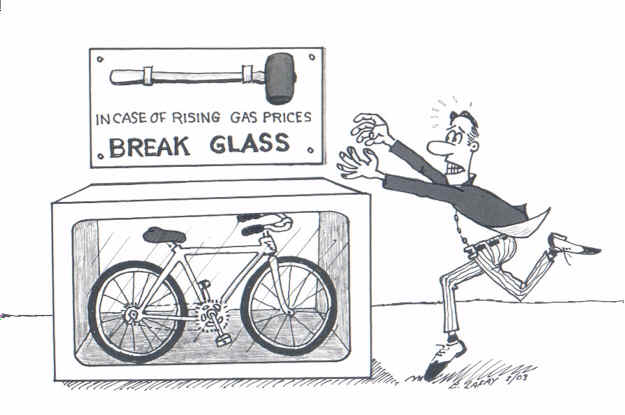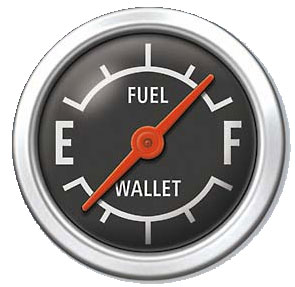With High gas prices, expensive car payments, traffic
delays, road rage, expanding waistlines, commuting by bicycle is an attractive alternative. There are many great reasons to
consider traveling to work by bicycle. It's an effective, healthy,
inexpensive, and fun alternative that is attracting more and more
commuters all over the world.
Check out our Commuter's References Guide and Employer's Reference Guide for biking to work.
The Benefits of cycling
Why Ride?
In the time we already spend getting to work, we can get the exercise we need, but "don't have time for."
Commuting to work by bike or for neighborhood errands is within easy reach of people of any level of fitness and a great way to get fit and stay healthy. Besides having fun and getting healthier, you’ll be improving our air quality and reducing traffic congestion.
The bicycle is the most energy-efficient form of travel ever devised—so you’ll be reducing energy use and our dependence on fossil fuels.
- Improved health and fitness: Biking is a low-stress, low-impact exercise that can be performed by people of all ages and fitness levels.
- Saving money: The only fuel you need is food! Cut your insurance costs by driving fewer miles in your car too!
- Easier & less expensive parking: With the proper locking device, you can park your bike safely much easier; you can park your bike closer to your destination and for free.
- Environmentally-friendly: Biking reduces the number of cars on the road, reducing traffic congestion. It is also a non-polluting mode of transportation!

Frequently Asked Commuter Questions
Is riding a bike in traffic during commute hours dangerous?
For maximum safety, take your rightful place in traffic and obey all traffic laws. With advance planning, you can find a route that avoids heavy traffic and other potential hazards. Consider taking a safety course. BIKEIOWA and other advocacy groups are working to see more courses offered.
Will biking lengthen my commute?
It depends. Some commutes will take longer by bicycle, while others, particularly short distance commutes, will be much quicker and more reliable because you won’t have to sit in traffic or wait for a bus. If your ride is roughly five miles or less, it will only take about 25 minutes. Consider that the time you spend on your bicycle is probably more relaxing and rewarding than other commute alternatives. Also, your commute by bike doubles as a workout so that’s one less trip to the gym you have to make.
How expensive is biking?
You may need to make an initial investment, but even if you buy a new bike and equipment, it should pay off in lower commute costs in no time. It's best to purchase a bike from a bicycle dealer who will fit the bike to you and provide follow-up adjustments and repair. Many dealers carry used bikes. While some bikes can cost thousands of dollars, you can get a good, reliable bike for just a few hundred dollars, especially if you’re only using it for short distances. And if you’re taking your bike outside or parking it at a parking garage or bike rack, you’re probably better off with a less expensive bike that won’t be a potential target for bike thieves.
Will my clothes get wrinkled on the way to work?
On a short, relatively flat ride, you will likely arrive in good shape. For longer rides, you'll find that racks, bike bags and special panniers are great for carrying a change of clothes to work wrinkle-free. You can also leave a small stock of work clothes at the office or use another commute option when you have special meetings that require dress attire.

“I’D BIKE TO WORK, BUT…”
People seem to have an infinite number of reasons why they can’t bike to work. Yet millions of people across the globe bike everyday, so there‘s an answer to virtually every objection. If you are looking for a response to, “I’d bike to work, but…” you might want to consider the following:
“It’s too dangerous.”
The greater risk is being sedentary. The certain health benefits of bicycling far outweigh the less likely risks of injury and death. One estimate is the benefits outweigh the risks by 20:1. And while everything we do involves some risk, including driving, risks can be minimized. If bicyclists simply follow traffic laws, they greatly reduce their chance of a crash and can ride with a high degree of safety. A course in bicycling skills can further reduce risk. The type of collision that potential cyclists seem to fear most, getting hit by a car from behind, is exceedingly rare--less than .3 of 1% of all crashes according to one expert.
“It’s too far.”
Bike one or two days a week. You don’t have to bike a long distance everyday. Combine your trip with small car commute to a trail head, or a half way point. Catch a ride with a co-worker one way and then bike the other. Drive in with your bike in the morning and bike home. The next day, reverse the process. Drive part of the way and bike the rest.
“I don’t have time.”
Combining exercise and commuting can actually save time.A Transportation Alternatives study shows that commutes under 3 miles are often faster by bike. Urban trips of 5-7 miles usually take about the same time.
“I don’t want to do it alone.”
Find a Riding partner. Participate in weekend rides, Join a team or watch the BIKEIOWA calendar for more information. Post a wanted ad in the BIKEIOWA forums or at your workplace.
“I need my car during the day.”
Most people don’t need a car every day of the week. Bike on the days you don’t. If travel is needed for a short trip, maybe you can bike instead. Share a ride with a coworker to run errands over lunch, go to a meeting, etc.
“I’ll get too sweaty.”
If the trip is not long and you ride at a slow pace, you don’t need to get any sweatier than you do while walking. If you can’t shower at your workplace, shower before you leave and take a sponge bath or use baby wipes when you arrive
“I don’t have a bike for commuting.”
Any bike can be used for commuting. You’ll want to consider accessories for any special needs you might have: baskets or panniers for carrying things, fenders for wet weather and lights for night riding
“I don’t know what route to take.”
Ask someone else who rides for suggestions. Check out the bike maps at www.BIKEIOWA.com Don’t be afraid to experiment with routes. A different afternoon route might be better than your morning route.
“I have to dress up for work.”
Drive one day a week and bring in several days worth of dress clothes. It will make your commute time quicker too!
BICYCLE COMMUTING FACTS
- More than half of all Americans live less than five
miles from where they work according to Bicycling magazine.
- Only 1.67% of Americans commute by bicycle.
- In Japan, 15% commute by bicycle
- About 12 bicycles can be parked in the space required
for one automobile.
- Traffic jams in the 29 major cities cost commuters an
estimated $24.3 billion each year.
- There are approximately 139 million automobiles in the
United States.
- The number of bicycles in the U.S. is estimated to be
about 103 million.
- One hundred bicycles can be produced for the same
energy and resources it takes to build one medium-sized automobile.
- The average cost of a new car in the U.S. is $13,532.
- The average cost of a new bicycle in the U.S. is $385.
- The average number of barrels of oil consumed daily in
the United States is 17 million.
- Driving consumes 43% of those barrels of oil. ·
Industrial world cities typically use at least one third of their land for
roads and parking lots for motor vehicles. · Commuting by bicycle produces
zero pollution.
- On average, the commute to work accounts for only one
out of five auto trips taken by drivers each day.
- Trips per day by purpose break down this way:
- Home to work = 1.27 trips per day
- Shopping = .98 trips per day
- Other personal business = 1.17 trips per day
- Social and recreational = .99 trips per
day
- Average miles per trip by purpose
- Home to work = 11.0 miles per trip
- Shopping = 5.1 miles per trip
- Oher personal business = 7.4 miles per trip
- Social and recreational = 11.8 miles per
trip
- For a comparison on true cost savings, consider that
you can drive your car to the grocery store and spend 35 cents for a bar of
soap, adding 7 cents for the gas, or you can ride your bike to the corner
convenience store and pay 41 cents, actually saving a penny and getting some
exercise at the same time.
- The number of bicycle commuters doubled between 1983
and 1990, according to the Bicycle Institute of America
- In China, bicycles outnumber cars 250 to 1.
We like Paul Dorn's Bike Commuting Tips